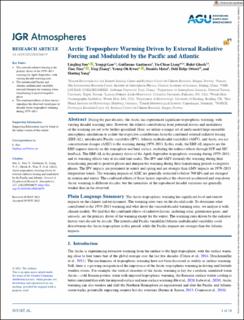| dc.contributor.author | Suo, Lingling | |
| dc.contributor.author | Gao, Yongqi | |
| dc.contributor.author | Gastineau, Guillaume | |
| dc.contributor.author | Liang, Yu-Chiao | |
| dc.contributor.author | Ghosh, Rohit | |
| dc.contributor.author | Tian, Tian | |
| dc.contributor.author | Zhang, Ying | |
| dc.contributor.author | Kwon, Young-Oh | |
| dc.contributor.author | Matei, Daniela | |
| dc.contributor.author | Otterå, Odd Helge | |
| dc.contributor.author | Yang, Shuting | |
| dc.date.accessioned | 2023-04-18T13:10:23Z | |
| dc.date.available | 2023-04-18T13:10:23Z | |
| dc.date.created | 2022-12-12T14:52:36Z | |
| dc.date.issued | 2022 | |
| dc.identifier.issn | 2169-897X | |
| dc.identifier.uri | https://hdl.handle.net/11250/3063615 | |
| dc.description.abstract | During the past decades, the Arctic has experienced significant tropospheric warming, with varying decadal warming rates. However, the relative contributions from potential drivers and modulators of the warming are yet to be further quantified. Here, we utilize a unique set of multi-model large-ensemble atmospheric simulations to isolate the respective contributions from the combined external radiative forcing (ERF-AL), interdecadal Pacific variability (IPV), Atlantic multidecadal variability (AMV), and Arctic sea-ice concentration changes (ASIC) to the warming during 1979–2013. In this study, the ERF-AL impacts are the ERF impacts directly on the atmosphere and land surface, excluding the indirect effects through SST and SIC feedback. The ERF-AL is the primary driver of the April–September tropospheric warming during 1979–2013, and its warming effects vary at decadal time scales. The IPV and AMV intensify the warming during their transitioning periods to positive phases and dampen the warming during their transitioning periods to negative phases. The IPV impacts are prominent in winter and spring and are stronger than AMV impacts on 1979–2013 temperature trends. The warming impacts of ASIC are generally restricted to below 700 hPa and are strongest in autumn and winter. The combined effects of these factors reproduce the observed accelerated and step-down Arctic warming in different decades, but the intensities of the reproduced decadal variations are generally weaker than in the observed. | en_US |
| dc.language.iso | eng | en_US |
| dc.rights | Navngivelse 4.0 Internasjonal | * |
| dc.rights.uri | http://creativecommons.org/licenses/by/4.0/deed.no | * |
| dc.title | Arctic Troposphere Warming Driven by External Radiative Forcing and Modulated by the Pacific and Atlantic | en_US |
| dc.title.alternative | Arctic Troposphere Warming Driven by External Radiative Forcing and Modulated by the Pacific and Atlantic | en_US |
| dc.type | Peer reviewed | en_US |
| dc.type | Journal article | en_US |
| dc.rights.holder | © 2022 The Authors | en_US |
| dc.description.version | publishedVersion | en_US |
| cristin.ispublished | true | |
| cristin.fulltext | original | |
| cristin.qualitycode | 2 | |
| dc.identifier.doi | 10.1029/2022JD036679 | |
| dc.identifier.cristin | 2092079 | |
| dc.source.journal | Journal of Geophysical Research (JGR): Atmospheres | en_US |
| dc.source.volume | 127 | en_US |
| dc.source.issue | 23 | en_US |
| dc.relation.project | Sigma2: NN2343K | en_US |
| dc.relation.project | Sigma2: NS9015K | en_US |
| dc.relation.project | EC/H2020/727852 | en_US |
| dc.relation.project | EU/JPI Climate-Oceans ROADMAP | en_US |
| dc.relation.project | Norges forskningsråd: 316618 | en_US |

